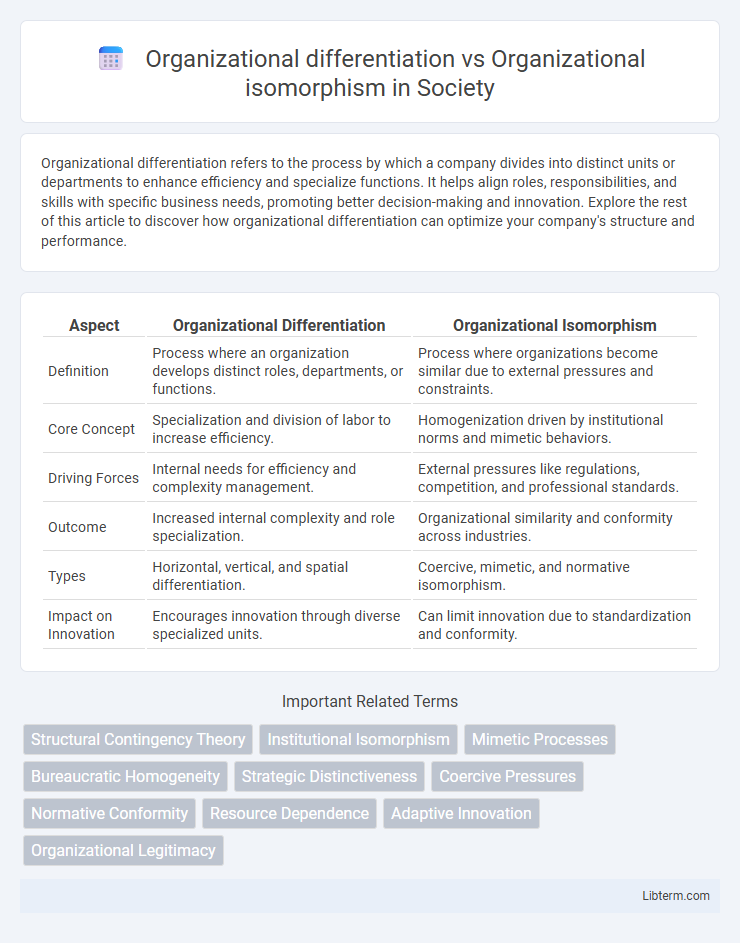Organizational differentiation refers to the process by which a company divides into distinct units or departments to enhance efficiency and specialize functions. It helps align roles, responsibilities, and skills with specific business needs, promoting better decision-making and innovation. Explore the rest of this article to discover how organizational differentiation can optimize your company's structure and performance.
Table of Comparison
| Aspect | Organizational Differentiation | Organizational Isomorphism |
|---|---|---|
| Definition | Process where an organization develops distinct roles, departments, or functions. | Process where organizations become similar due to external pressures and constraints. |
| Core Concept | Specialization and division of labor to increase efficiency. | Homogenization driven by institutional norms and mimetic behaviors. |
| Driving Forces | Internal needs for efficiency and complexity management. | External pressures like regulations, competition, and professional standards. |
| Outcome | Increased internal complexity and role specialization. | Organizational similarity and conformity across industries. |
| Types | Horizontal, vertical, and spatial differentiation. | Coercive, mimetic, and normative isomorphism. |
| Impact on Innovation | Encourages innovation through diverse specialized units. | Can limit innovation due to standardization and conformity. |
Understanding Organizational Differentiation
Organizational differentiation involves the process by which organizations develop unique structures, roles, and strategies to adapt effectively to specific environmental demands and competitive landscapes. This differentiation enhances innovation, efficiency, and specialization by allowing distinct departments or units to focus on specialized tasks aligned with organizational goals. Understanding organizational differentiation is crucial for recognizing how diversity in organizational design contributes to competitive advantage and responsiveness to market changes.
Defining Organizational Isomorphism
Organizational isomorphism refers to the process by which organizations within the same field become increasingly similar due to coercive, mimetic, and normative pressures. It contrasts with organizational differentiation, which emphasizes unique structures and strategies to maintain competitive advantage. Understanding organizational isomorphism helps explain the homogenization of practices and structures across industries despite varying environmental conditions.
Key Drivers of Organizational Differentiation
Organizational differentiation arises from diverse core competencies, unique strategic goals, and varying external market demands, fostering innovation and competitive advantage. Key drivers include technological capabilities, organizational culture, and leadership styles that shape distinct operational processes and structures. These factors create heterogeneity within industries, contrasting with organizational isomorphism, which emphasizes homogenization due to regulatory pressure, normative expectations, and mimetic behaviors.
Mechanisms of Organizational Isomorphism
Mechanisms of organizational isomorphism include coercive pressures from regulatory bodies, mimetic processes driven by uncertainty leading organizations to imitate successful peers, and normative influences stemming from professionalization within industries. These mechanisms compel organizations to adopt similar structures, practices, and strategies, reducing differentiation over time. Understanding these forces is crucial for analyzing why organizations in the same field increasingly resemble each other despite initial differences.
Comparative Analysis: Differentiation vs Isomorphism
Organizational differentiation emphasizes unique structures and processes tailored to specific environmental demands, promoting innovation and competitive advantage. Organizational isomorphism drives homogeneity as organizations mimic industry leaders to gain legitimacy, stability, and predictability. Comparing the two reveals differentiation fosters adaptability through diversity, while isomorphism enhances conformity and coherence within institutional fields.
Impact on Competitive Advantage
Organizational differentiation enhances competitive advantage by fostering unique capabilities and distinct strategic approaches that set a company apart in the marketplace, enabling innovation and targeted customer value. In contrast, organizational isomorphism leads to homogeneity by encouraging firms to adopt similar structures and practices, which can reduce differentiation and limit the scope for sustainable competitive advantage. Firms leveraging differentiation maintain a competitive edge through agility and innovation, while those conforming to isomorphism risk commoditization and increased rivalry intensity.
Case Studies: Real-World Examples
Case studies demonstrate organizational differentiation through companies like Apple, which innovates with unique product designs and marketing strategies to stand out in the tech industry. In contrast, organizational isomorphism is evident in fast-food chains such as McDonald's and Burger King, which adopt similar operational processes and menu offerings to conform to industry standards and customer expectations. These examples highlight how differentiation drives competitive advantage through uniqueness, while isomorphism promotes efficiency and legitimacy by mimicking successful practices.
Challenges of Balancing Differentiation and Isomorphism
Balancing organizational differentiation and isomorphism poses challenges in maintaining unique competitive advantages while conforming to industry norms and regulations. Excessive differentiation can lead to operational inefficiencies and reduced legitimacy, whereas overemphasis on isomorphism may stifle innovation and adaptability. Organizations must strategically align distinct capabilities with standard practices to optimize performance and sustainability in dynamic markets.
Strategic Implications for Leaders
Organizational differentiation enhances competitive advantage by promoting unique capabilities, innovation, and adaptive strategies tailored to specific market demands. Organizational isomorphism drives conformity through mimetic, coercive, or normative pressures, potentially limiting flexibility but improving legitimacy and stakeholder trust. Strategic leaders must balance differentiation to foster innovation with isomorphism to maintain credibility and navigate regulatory or industry standards effectively.
Emerging Trends in Organizational Structure
Emerging trends in organizational structure highlight a balance between organizational differentiation and organizational isomorphism as firms strive for competitive advantage while adhering to industry norms. Differentiation drives innovation through specialized functions and decentralized decision-making, enabling adaptability in dynamic markets. Conversely, isomorphism leads to homogenization via mimetic, coercive, and normative pressures, promoting legitimacy and stability within institutional environments.
Organizational differentiation Infographic

 libterm.com
libterm.com